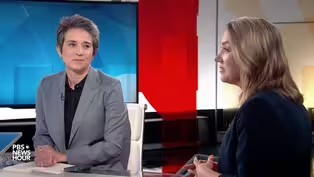
Affirmative action ruling could impact med school diversity
Clip: 7/10/2023 | 5m 43sVideo has Closed Captions
Affirmative action ruling raises concerns over impact on medical school diversity
There are concerns about how the Supreme Court’s ruling striking down affirmative action in college admissions could affect the medical profession. Currently, just 5.7 percent of doctors in the U.S. are Black and nearly 7 percent are Hispanic. There’s worry about what this ruling could mean for the pipeline of who eventually provides healthcare. Amna Nawaz discussed more with Dr. Utibe Essien.
Problems playing video? | Closed Captioning Feedback
Problems playing video? | Closed Captioning Feedback
Major corporate funding for the PBS News Hour is provided by BDO, BNSF, Consumer Cellular, American Cruise Lines, and Raymond James. Funding for the PBS NewsHour Weekend is provided by...

Affirmative action ruling could impact med school diversity
Clip: 7/10/2023 | 5m 43sVideo has Closed Captions
There are concerns about how the Supreme Court’s ruling striking down affirmative action in college admissions could affect the medical profession. Currently, just 5.7 percent of doctors in the U.S. are Black and nearly 7 percent are Hispanic. There’s worry about what this ruling could mean for the pipeline of who eventually provides healthcare. Amna Nawaz discussed more with Dr. Utibe Essien.
Problems playing video? | Closed Captioning Feedback
How to Watch PBS News Hour
PBS News Hour is available to stream on pbs.org and the free PBS App, available on iPhone, Apple TV, Android TV, Android smartphones, Amazon Fire TV, Amazon Fire Tablet, Roku, Samsung Smart TV, and Vizio.
Providing Support for PBS.org
Learn Moreabout PBS online sponsorshipAMNA NAWAZ: Doctors, nurses, hospitals and many others are concerned about how the Supreme Court's ruling striking down affirmative action in college admissions could affect the medical profession.
Currently, just 5.7 percent of all doctors in the U.S. are Black, and nearly 7 percent are Hispanic, while 64 percent are white.
Black and Latino applicants still make up a small percentage of those who go to medical school.
And there's worry about what this ruling could mean for the pipeline of who eventually provides health care.
For more on those concerns, I'm joined by Dr. Utibe Essien.
He's an internal medicine physician and assistant professor of medicine at UCLA.
Dr. Essien, welcome, and thanks for joining us.
Before we get into the details of the ruling, I just have to ask, what was your initial reaction when you first heard the Supreme Court's ruling?
DR. UTIBE ESSIEN, David Geffen School of Medicine, UCLA: Absolutely.
Thanks so much for having me, Amna.
And, sadly, while we were expecting this news, it was pretty much a gut punch.
And it was really devastating to see that, despite years of proof that affirmative action does improve diversity in undergraduate and medical schools, that the court has decided to let go of this decision.
And so I was pretty devastated on Thursday.
I know a lot of my friends and colleagues were as well.
AMNA NAWAZ: So, those numbers we just mentioned in the introduction, that was even with affirmative action in place.
Why are those numbers so low?
Help us understand.
DR. UTIBE ESSIEN: So it's really important to appreciate that this is not just at random, right?
A paper that my colleagues and I published led by one of my friends, Dr. Fais (ph), showed that some of the reasons for the low numbers are related to just the journey towards applying to medical school, so higher rates of pre-medical school loans and less likelihood to be able to pay for the preparatory materials to be able to get into medical school, and even having parents who are less likely to have a college education.
Some of these are factors are what drives Black and Hispanic and Native American lower rates of physicians, much less some of the systemic and structural challenges that we have around education here in the U.S. AMNA NAWAZ: Just to underscore some of those numbers, when you look at the 2022 and 2023 school year, in terms of first-year enrollees and medical school, these are the numbers we have.
Black students made up just 10 percent of first-year medical students.
Latino students made up just 12 percent of medical school students.
But, Dr. Essien, a few states, we should point out, had already banned affirmative action at the state level.
Did you see an impact in terms of that in those states, in terms of who ends up going to medical school and diversity of those classes?
DR. UTIBE ESSIEN: Absolutely.
So we're here in California, I am, rather.
And they banned affirmative action back in 1996.
And we have seen that, here in California, the rates of Black and Hispanic individuals going into undergraduate and medical schools really significantly dropped since that ruling in '96.
We had a paper that came out last year that showed, not just here in California, but in seven other states that had affirmative action bans, the number of individuals from minoritized groups continues to drop in medical schools.
And so we have precedents for what is going to happen now that this is federal policy and not national -- not just state policy, and it's really devastating for the future of the health of our communities.
AMNA NAWAZ: Help us understand that a little better, though.
In medical -- in the medical field, in particular, why is that diversity of doctors so important in terms of providing health care?
DR. UTIBE ESSIEN: Absolutely.
I think it's important to realize this is not just a moral imperative, the right thing to do, but that diversity really does save lives.
We have studies that show that having a doctor who looks like you, it makes you more likely to take preventive screenings such as flu vaccines, or more likely to go for more invasive procedures like heart catheterizations.
And in a study published back in April, it showed that, for every 10 percent of increase in Black primary care doctors within a county, there's a 30 day increase in life expectancy for Black individuals.
So, again, literally having diverse doctors saves lives.
And my concern is that this policy, this decision is going to take us backwards.
AMNA NAWAZ: So, what now, Dr. Essien?
We're in a post-affirmative action America.
What specific steps can institutions take to still work towards that same diversity in medical schools and the medical profession?
DR. UTIBE ESSIEN: It's a question we're all asking right now.
There are three things that my colleagues and I kind of put forth in op-ed last week around this.
And the first is really strengthening holistic review, really focusing on the journey that our patients -- or our students, rather, take towards becoming physicians, and not wholly focused on the MCAT scores, that test that we have taken to get into medical school, or their GPAs.
We have to ensure that those who are reviewing applications actually are anti-racist in their approach and are able to capture the full breadth of our students' journeys to go in towards medicine.
And, lastly, we have to eliminate some of the economic costs.
That test that I mentioned earlier, it costs $320 to take to get into medical school.
The cost of medical school itself is exorbitant.
I left school with $250,000 worth of loans.
And those are some of the steps that we need to take to be able to increase the diversity of our medical schools.
AMNA NAWAZ: In the few seconds, I have to -- I have to ask, what's your greatest concern if this problem isn't addressed?
DR. UTIBE ESSIEN: You know, as I mentioned, we have a disparities issue in our country.
We didn't just see that with COVID.
But, over the last year, we see a seven-year gap between life expectancy in white Americans and Black Americans.
My worry is that that gap is going to widen in this post-affirmative action world.
And I hope that we will be able to advocate for the reversal of some of these policies that were just made.
AMNA NAWAZ: Dr. Utibe Essien, assistant professor of medicine at UCLA, thank you so much for joining us tonight.
We appreciate it.
DR. UTIBE ESSIEN: Thanks for having me.
'Black Mirror' creator on why the show has gripped audiences
Video has Closed Captions
Clip: 7/10/2023 | 7m 15s | 'Black Mirror' creator on why the techno-dystopian show has gripped audiences (7m 15s)
Cycle of violence pushes young Palestinians to take up arms
Video has Closed Captions
Clip: 7/10/2023 | 7m 13s | Cycle of violence and economic turmoil pushes young Palestinians to take up arms (7m 13s)
Eastern U.S. hit with flooding, heat wave drags on in West
Video has Closed Captions
Clip: 7/10/2023 | 7m 52s | Eastern U.S. hit with flooding as heat wave drags on in West and South (7m 52s)
Lawsuit filed by Tulsa Race Massacre survivors dismissed
Video has Closed Captions
Clip: 7/10/2023 | 7m 6s | Okla. judge dismisses restitution lawsuit filed by last survivors of Tulsa Race Massacre (7m 6s)
Tamara Keith and Amy Walter on Biden's trip to Europe
Video has Closed Captions
Clip: 7/10/2023 | 8m 52s | Tamara Keith and Amy Walter on Biden's trip to Europe and presidential campaign politics (8m 52s)
U.S. ambassador to NATO discusses future of alliance
Video has Closed Captions
Clip: 7/10/2023 | 6m 27s | U.S. ambassador to NATO discusses future of alliance ahead of crucial summit (6m 27s)
Providing Support for PBS.org
Learn Moreabout PBS online sponsorshipSupport for PBS provided by:
Major corporate funding for the PBS News Hour is provided by BDO, BNSF, Consumer Cellular, American Cruise Lines, and Raymond James. Funding for the PBS NewsHour Weekend is provided by...
















